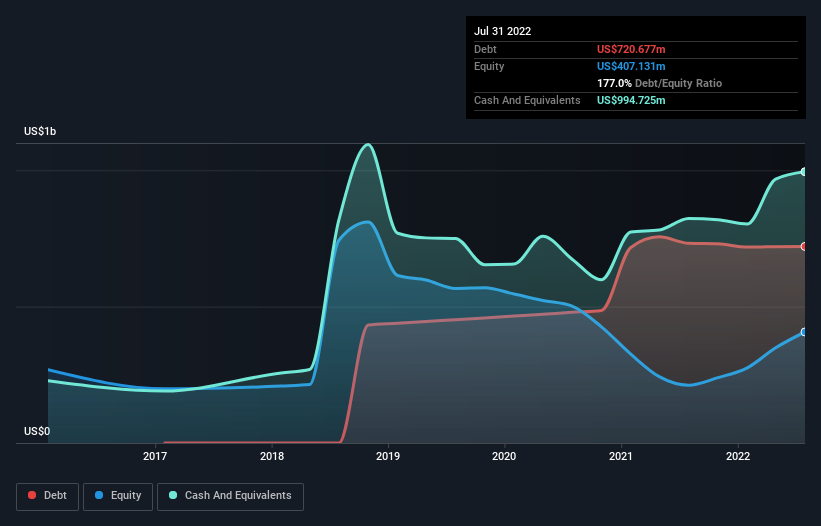- United States
- /
- Software
- /
- NasdaqGS:DOCU
Health Check: How Prudently Does DocuSign (NASDAQ:DOCU) Use Debt?

Some say volatility, rather than debt, is the best way to think about risk as an investor, but Warren Buffett famously said that 'Volatility is far from synonymous with risk.' It's only natural to consider a company's balance sheet when you examine how risky it is, since debt is often involved when a business collapses. Importantly, DocuSign, Inc. (NASDAQ:DOCU) does carry debt. But should shareholders be worried about its use of debt?
Why Does Debt Bring Risk?
Debt is a tool to help businesses grow, but if a business is incapable of paying off its lenders, then it exists at their mercy. In the worst case scenario, a company can go bankrupt if it cannot pay its creditors. However, a more common (but still painful) scenario is that it has to raise new equity capital at a low price, thus permanently diluting shareholders. Having said that, the most common situation is where a company manages its debt reasonably well - and to its own advantage. The first thing to do when considering how much debt a business uses is to look at its cash and debt together.
Check out our latest analysis for DocuSign
What Is DocuSign's Net Debt?
The chart below, which you can click on for greater detail, shows that DocuSign had US$720.7m in debt in July 2022; about the same as the year before. However, it does have US$994.7m in cash offsetting this, leading to net cash of US$274.0m.

How Healthy Is DocuSign's Balance Sheet?
The latest balance sheet data shows that DocuSign had liabilities of US$1.40b due within a year, and liabilities of US$858.0m falling due after that. Offsetting this, it had US$994.7m in cash and US$348.9m in receivables that were due within 12 months. So its liabilities outweigh the sum of its cash and (near-term) receivables by US$916.6m.
Since publicly traded DocuSign shares are worth a total of US$8.87b, it seems unlikely that this level of liabilities would be a major threat. However, we do think it is worth keeping an eye on its balance sheet strength, as it may change over time. While it does have liabilities worth noting, DocuSign also has more cash than debt, so we're pretty confident it can manage its debt safely. When analysing debt levels, the balance sheet is the obvious place to start. But it is future earnings, more than anything, that will determine DocuSign's ability to maintain a healthy balance sheet going forward. So if you want to see what the professionals think, you might find this free report on analyst profit forecasts to be interesting.
In the last year DocuSign wasn't profitable at an EBIT level, but managed to grow its revenue by 30%, to US$2.3b. With any luck the company will be able to grow its way to profitability.
So How Risky Is DocuSign?
Although DocuSign had an earnings before interest and tax (EBIT) loss over the last twelve months, it generated positive free cash flow of US$440m. So although it is loss-making, it doesn't seem to have too much near-term balance sheet risk, keeping in mind the net cash. The good news for DocuSign shareholders is that its revenue growth is strong, making it easier to raise capital if need be. But we still think it's somewhat risky. When analysing debt levels, the balance sheet is the obvious place to start. But ultimately, every company can contain risks that exist outside of the balance sheet. Case in point: We've spotted 1 warning sign for DocuSign you should be aware of.
At the end of the day, it's often better to focus on companies that are free from net debt. You can access our special list of such companies (all with a track record of profit growth). It's free.
New: Manage All Your Stock Portfolios in One Place
We've created the ultimate portfolio companion for stock investors, and it's free.
• Connect an unlimited number of Portfolios and see your total in one currency
• Be alerted to new Warning Signs or Risks via email or mobile
• Track the Fair Value of your stocks
Have feedback on this article? Concerned about the content? Get in touch with us directly. Alternatively, email editorial-team (at) simplywallst.com.
This article by Simply Wall St is general in nature. We provide commentary based on historical data and analyst forecasts only using an unbiased methodology and our articles are not intended to be financial advice. It does not constitute a recommendation to buy or sell any stock, and does not take account of your objectives, or your financial situation. We aim to bring you long-term focused analysis driven by fundamental data. Note that our analysis may not factor in the latest price-sensitive company announcements or qualitative material. Simply Wall St has no position in any stocks mentioned.
About NasdaqGS:DOCU
DocuSign
Provides electronic signature solution in the United States and internationally.
Solid track record with excellent balance sheet.


